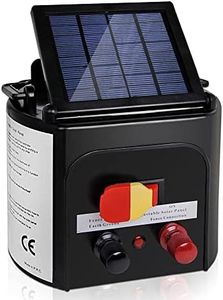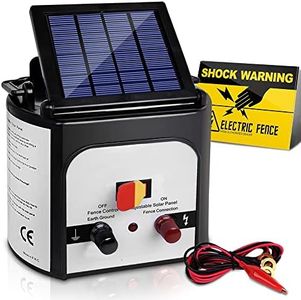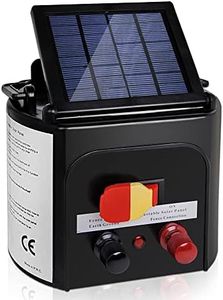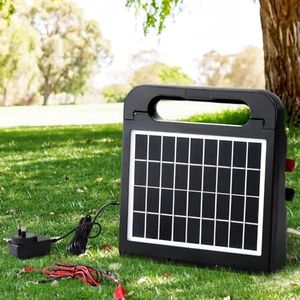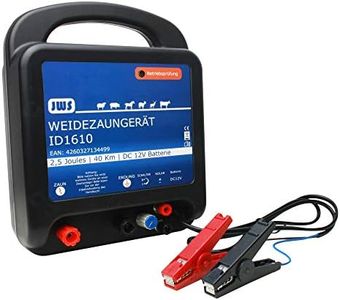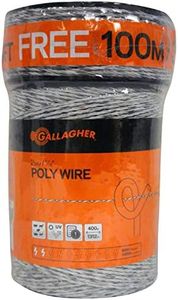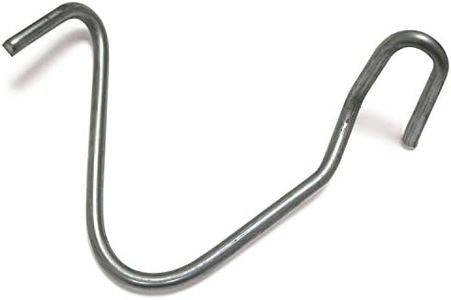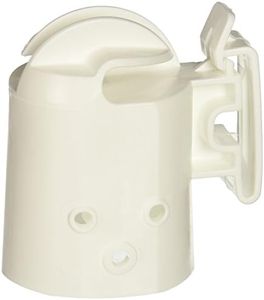We Use CookiesWe use cookies to enhance the security, performance,
functionality and for analytical and promotional activities. By continuing to browse this site you
are agreeing to our privacy policy
10 Best Cattle Electric Fencers
From leading brands and best sellers available on the web.Buying Guide for the Best Cattle Electric Fencers
Choosing the right cattle electric fencer is important for the safety and containment of your livestock. A good fencer will ensure that your animals stay within their designated areas while keeping predators out. When shopping for an electric fencer, you should consider the size of your land, the type of fencing material, the availability of power sources, and the types of animals you plan to contain. Understanding the main specifications will help you pick the best fit for your needs.Power SourceThe power source refers to how the fencer is powered—options typically include mains-powered (plugged into the electricity grid), battery-powered (using replaceable or rechargeable batteries), and solar-powered (utilizing sunlight to charge an internal battery). Mains-powered fencers are best for permanent installations on properties with reliable electricity, while battery and solar units are more portable and suited for remote areas or rotational grazing. Your choice should be guided by the distance from electrical outlets and how mobile you need the system to be.
Joule OutputJoule output measures the strength of the electric pulse sent through the fence and is a key indicator of a fencer’s effectiveness. Lower joule values (under 1 joule) are suitable for small paddocks or for keeping smaller, less challenging animals. Medium values (1-5 joules) fit medium pastures and standard livestock like cattle or horses. High joule fencers (above 5 joules) are designed for large areas, tough livestock, or fences with heavy vegetation. Pick a joule rating based on the fence length, type of animals, and amount of weed load—the longer and more overgrown your fence lines, the more joule output you’ll need.
Miles (or Kilometers) of Fence CoverageThis spec shows the maximum fence length the fencer can adequately energize. Coverage claims often refer to ‘ideal’ or ‘clean’ fence conditions, which means a straight wire with no vegetation or interference. Real-life situations, with multiple wires and some weeds touching the fence, will reduce the coverage significantly. Match the fencer’s coverage rating to your property by measuring your actual fence lines, and consider a higher rating if you have multiple strands of wire or complex setups.
Weather ResistanceWeather resistance is about how well the electric fencer can withstand outdoor conditions such as rain, heat, cold, or dust. Some fencers are built for outdoor use with watertight and UV-resistant enclosures, while others are intended to be placed inside or under cover. If your installation location exposes the unit to the elements, be sure to get a model specifically rated for outdoor or all-weather use to ensure longevity and reliability.
Animal CompatibilityDifferent fencers are suitable for different types of animals. Lighter-duty units can deter small animals or pets, while more powerful models are needed for cattle, horses, or even for keeping out larger predators. Your intended livestock should guide your choice: strong-willed or thick-skinned animals like bulls or wildlife require units with higher power and reliability, while smaller or more sensitive animals can be managed with less output.
Safety FeaturesSafety features include things like overcharge protection, lightning protection, and low-impedance tech (which limits the pulse duration to prevent harm). These are important for protecting your animals, your property, and the fencer itself. If you have vulnerable animals or if safety is a key concern, look for units that advertise advanced safety mechanisms or compliance with relevant animal welfare guidelines.
